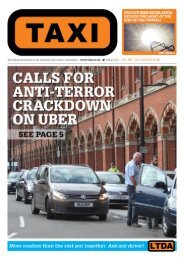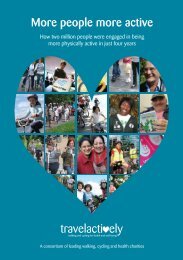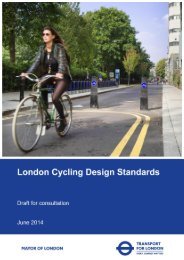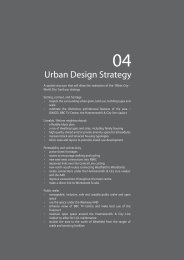Travel in London Travel in London
travel-in-london-report-8
travel-in-london-report-8
You also want an ePaper? Increase the reach of your titles
YUMPU automatically turns print PDFs into web optimized ePapers that Google loves.
11. Spotlight: How has travel by <strong>London</strong>ers changed – <strong>in</strong>sights from 10 years of the <strong>London</strong> <strong>Travel</strong><br />
Demand Survey (LTDS)<br />
11.6 Are chang<strong>in</strong>g work<strong>in</strong>g patterns affect<strong>in</strong>g travel demand?<br />
Introduction<br />
<strong>Travel</strong> to/from and <strong>in</strong> the course of work is the most significant reason for personal<br />
travel, account<strong>in</strong>g for 28.8 per cent of all trips made by <strong>London</strong>ers on an average<br />
weekday (2014/15). Key features of work travel, such as a focus on the morn<strong>in</strong>g and<br />
even<strong>in</strong>g peak periods, are well known – for example it is peak demand that drives<br />
the requirement for capacity on the transport networks. However, it is also evident<br />
from the wider literature that work<strong>in</strong>g patterns are chang<strong>in</strong>g rapidly, with <strong>in</strong>creas<strong>in</strong>g<br />
flexibility of work<strong>in</strong>g hours, <strong>in</strong>creas<strong>in</strong>g home or remote work<strong>in</strong>g, and the impact of<br />
technology on bus<strong>in</strong>ess travel. While all of these trends have been apparent for<br />
some time, it is not clear that they have fed through to significant differences <strong>in</strong><br />
travel patterns at the aggregate level. This section looks at what LTDS can tell us<br />
about changes <strong>in</strong> work-related travel over the past 10 years.<br />
Work-related travel – overall trip rates<br />
Table 11.1 shows the total number of trips and associated average trip rates for<br />
work-related travel by <strong>London</strong> residents. The most strik<strong>in</strong>g observation is that there<br />
has been a clear fall <strong>in</strong> the average number of trips made per person per day to or<br />
from a usual workplace (ie commut<strong>in</strong>g trips). This equates to 3.4 per cent over the<br />
10-year review period, or a reduction of about 0.4 per cent per year.<br />
The trend for trips made <strong>in</strong> the course of work, typically on employer’s bus<strong>in</strong>ess, is<br />
however not so clear. If the first year of the available series (2005/06) is omitted as<br />
be<strong>in</strong>g atypical, the trend would be best characterised as broadly stable over the<br />
review period. Therefore, there is evidence that people on average are mak<strong>in</strong>g fewer<br />
regular commuter trips, but there is no strong evidence of a trend, either positive or<br />
negative, <strong>in</strong> work-related employer’s bus<strong>in</strong>ess travel (all on a per capita basis).<br />
A feature of <strong>in</strong>terest is the change dur<strong>in</strong>g the years affected by the economic<br />
recession. While there was a relatively sharp fall <strong>in</strong> commut<strong>in</strong>g trip rates at this<br />
time, they have not recovered correspond<strong>in</strong>gly as the economy has improved –<br />
suggest<strong>in</strong>g that the recession may have been a catalyst for embedd<strong>in</strong>g new work<strong>in</strong>g<br />
practices as the economy has recovered.<br />
<strong>Travel</strong> <strong>in</strong> <strong>London</strong>, Report 8 221








